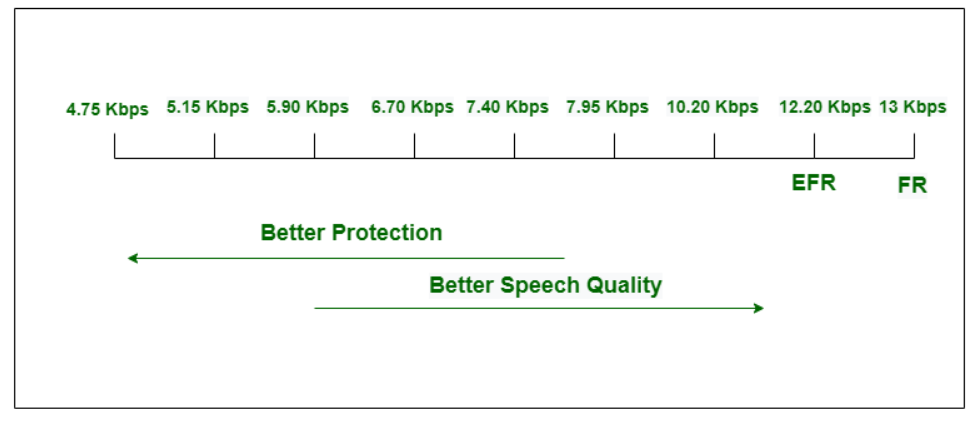What is AMR(Adaptive Multi-Rate Codec)?
Last Updated :
09 Jul, 2020
AMR stands for Adaptive Multi-Rate Codec. AMR is an audio compressed speech coding algorithm. This coding algorithm operates at 8-bit rates, ranging from 4.75 to 12.2 kbps, and is specially invented to improve robustness. AMR uses various technologies such as ACELP, DTX, VAD, and CNG. Many modern mobile phones use the AMR file format in order to store spoken audio. The common filename extension is .amr. Even, there exist other formats of AMR which can even store videos. In October 1999, AMR was adopted as standard speech codec by 3GPP.
History
AMR was adopted by 3GPP as the standard speech codec in October 1999. It is now widely used in GSM[5] and UMTS and it uses link adaptation to select from one of eight different bit rates based on link conditions.
Usage
The usage of AMR requires optimized link adaptation that selects the best codec mode to meet the local radio channel and capacity requirements. If the radio conditions are bad, the source coding is reduced and the channel coding is increased. This improves the quality and robustness of the network connection while sacrificing some voice clarity. The new intelligent system allows the network operator to prioritize capacity or quality per base station.
There are 14 modes of the AMR codec, out of which Eight are available on FR (full rate channel) and Six are on HR (half-rate channel) :
| MODE |
BITRATE (kbit/s) |
CHANNEL |
| AMR_12.20 |
12.20 |
FR |
| AMR_10.20 |
10.20 |
FR |
| AMR_7.95 |
7.95 |
FR/HR |
| AMR_7.40 |
7.40 |
FR/HR |
| AMR_6.70 |
6.70 |
FR/HR |
| AMR_5.90 |
5.90 |
FR/HR |
| AMR_5.15 |
5.15 |
FR/HR |
| AMR_4.75 |
4.75 |
FR/HR |
| AMR_SID |
1.80 |
FR/HR |
AMR Concept
AMR allows the usage of multiple coding schemes. The higher speech bandwidth schemes offer good speech quality and low error protection. While low speech bandwidth schemes provide low speech quality and high error protection.

Types Of AMR
AMR is available in 2 versions:
- AMR-NB: Adaptive Multi-rate narrowband speech codec was adopted by 3GPP in 1998. This codec generates the speech bandwidth of 300–3400 Hz. AMR-NB uses algebraic code excited linear prediction (ACELP) technique to compress speech at a bit level.
- AMR-WB: Unlike AMR_NB, the speech bandwidth of Adaptive Multi-rate wide band is 50–7000 Hz. AMR-WB is said to be a patented wideband speech audio coding standard algorithm and uses ACELP technology.
Features Of AMR
- The Sample frequency of AMR is 8 kHz/13-bit which is filtered to 200–3400 Hz.
- AMR has 8 source codec of bit rates 12.2, 10.2, 7.95, 7.40, 6.70, 5.90, 5.15 and 4.75 kbit/s.
- In order to reduce bandwidth during silence periods, AMR uses different technologies like discontinuous transmission (DTX), voice activity detection (VAD) and comfort noise generation (CNG).
- AMR is a hybrid speech coder that transmits both speech parameters and waveform signals.
- The complexity of the AMR algorithm is rated 5 using a relative scale.
- The opinion score of AMR is 12.2 kbit/s, which is given by PSQM testing under ideal conditions.
Applications Of AMR
- AMR is used in Digital telephony such as VoIP, Wi-Fi, satellite telephony, Push to talk over Cellular, video telephony, and 3G circuit-switched telephony.
- AMR is also used in Network analysis and simulation tools.
- Media players, Media servers, and Media gateways also use AMR.
- Voicemail/Unified Messaging is done with the help of AMR.
- AMR is also an essential part of Consumer electronics, Content creator tools, Test and measurement equipment, and Toys.
- The main use of AMR is in Multimedia-Audio and videoconferencing, digital radio broadcasting, audiobooks, ringtones, etc.
Advantages Of AMR
- Since the speech bandwidth of AMR is wider, so it posses superior sound quality.
- During network congestion, AMR uses low bit rates in order to preserve audio quality.
- AMR is dynamically adaptable to all kinds of network conditions.
- AMR provides good quality speech at low cost and with great robustness.
- AMR is compatible with all types of operating systems like Windows, Linux, Android, iOS.
- AMR maximize the possibility of receiving signals by trading off the speech bit rate to channel coding.
- AMR consists of 8 rates so it is the most widely used codec in the whole world.
Disadvantages Of AMR
- There are many delays in the voice path of AMR.
- AMR doesn’t support Music reproduction (consumer audio).
- AMR doesn’t have DRM (Digital Right Management).
Like Article
Suggest improvement
Share your thoughts in the comments
Please Login to comment...